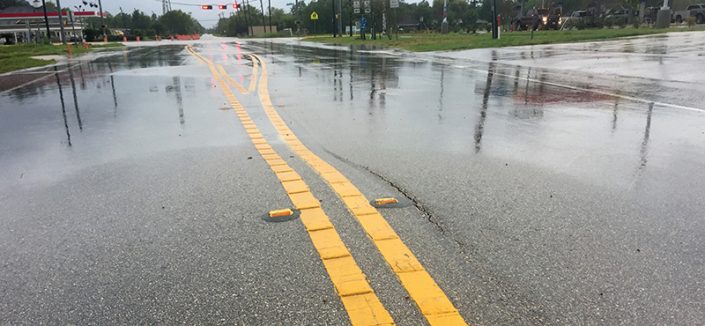TTI investigates odd behavior of Texas highways after hurricane

Image: Texas A&M Transportation Institute
Hurricane Harvey’s impact on Texas was unprecedented in many ways, including rainfall amounts, property damage and human misery. There was also unprecedented disruption and damage to Texas roadways. About a mile of State Highway 6 in Harris County, from Clay Road to Interstate 10, was covered with up to seven feet of water for 14 days. Multiple farm-to-market roads in Brazoria County were also submerged for days by one to seven feet of water.
As a result, many of these roadways exhibited characteristics that Texas Department of Transportation (TxDOT) Houston District personnel had never seen before. In five locations, the pavement bulged 12 inches above the normal road surface. In other locations, continuous streams of air bubbles escaped from cracks or joints in the road. TxDOT was concerned the bubbles might have been from damaged pipelines. When the bubbles were deemed harmless, the question became, “Where are these coming from?”
What was the explanation? Were areas beneath the pavement washed out? Was the pavement structure stable? Had asphalt delaminated from the concrete base? Could the roads possibly collapse? The roads couldn’t be opened without answers.
TxDOT asked the Texas A&M Transportation Institute (TTI) Senior Research Engineer Tom Scullion and his team of forensic pavement investigators, Research Specialist Lee Gustavus and Research Associate Jason Huddleston, to survey the affected roadways and assess the damage. Using ground-penetrating radar, TTI’s total pavements acceptance device (TPAD) automated rolling deflectometer and core sampling, TTI evaluated the health of all the affected roadways. State Highway 6 was first. It carries tens of thousands of vehicles each day, so getting it open was critical.
“TTI has some unique, specialized equipment,” Scullion said. “From the data we collected, we saw no indication of delaminations or washout, voided areas. We recorded deflections every two inches down the road. There were no anomalies in those data. After two weeks underwater, the asphalt was still bonded to the concrete, which was attributed to an excellent asphalt rubber seal coat bonding the asphalt and concrete layers together.” Following the assessment, the highway was reopened to traffic.
Mark Wooldridge, director of maintenance for the TxDOT Houston District, said, “TTI’s equipment and support were exceptional. The quick, timely response allowed us to verify that damage was not present on the roadways in question and enabled reopening of the roadways to traffic. The special equipment provided a much more thorough and accurate evaluation of the pavement structure than point testing, and the immediate interpretation and availability of data facilitated quick decision making.”

